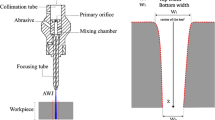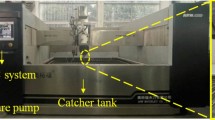Abstract
In abrasive waterjet (AWJ) process, abrasive properties are of critical factors that influence machining performances. Abrasive process parameters including abrasive material, size and flow rate, exert a significant impact on cutting ability and quality of AWJ. In this paper, monolithic abrasive material (garnet, alumina and silicon carbide) and corresponding mixing abrasive materials are adopted to evaluate the effect of abrasive process parameters on the cutting ability and quality, respectively. Two kinds of cutting experiments are conducted with a monolithic abrasive to explore the influence of variation in abrasive material, size and flow rate on the machining performance. The cutting depth experiments for evaluating the cutting ability in terms of cutting depth are conducted with a right trapezoid aluminium alloy block. The kerf cutting experiments are taken to evaluate the cutting quality by the kerf taper angle, kerf width and surface roughness. On this basis, AWJ experiments with mixing abrasive materials are taken to probe into the composition of mixing abrasives’ effect on cutting performance. It is found that the abrasives consisting of 75% alumina and 25% garnet in mass fraction lead to a maximum cutting depth of 41.7 mm and the smallest surface roughness of Ra 2.1 μm under the flow rate of 130 g/min.












Similar content being viewed by others
References
Hashish M (1989) A model for abrasive-waterjet (awj) machining. J Eng Mater Technol ASME 111:154–162. https://doi.org/10.1115/1.3226448
Axinte DA, Karpuschewski B, Kong MC, Beaucamp AT (2014) High energy fluid jet machining (HEFJet-Mach): from scientific and technological advances to niche industrial applications. CIRP Ann Technol 63:751–771. https://doi.org/10.1016/j.cirp.2014.05.001
Rabani A, Madariaga J, Bouvier C, Axinte D (2016) An approach for using iterative learning for controlling the jet penetration depth in abrasive waterjet milling. J Manuf Process 22:99–107. https://doi.org/10.1016/j.jmapro.2016.01.014
Khan AA, Haque MM (2007) Performance of different abrasive materials during abrasive water jet machining of glass. J Mater Process Technol 191:404–407. https://doi.org/10.1016/j.jmatprotec.2007.03.071
Fowler G, Pashby IR, Shipway PH (2009) The effect of particle hardness and shape when abrasive water jet milling titanium alloy Ti6Al4V. Wear 266:613–620. https://doi.org/10.1016/j.wear.2008.06.013
Boud F, Carpenter C, Folkes J, Shipway PH (2010) Abrasive waterjet cutting of a titanium alloy: the influence of abrasive morphology and mechanical properties on workpiece grit embedment and cut quality. J Mater Process Technol 210:2197–2205. https://doi.org/10.1016/j.jmatprotec.2010.08.006
Wang J (2009) Particle velocity models for ultra-high pressure abrasive waterjets. J Mater Process Technol 209:4573–4577. https://doi.org/10.1016/j.jmatprotec.2008.10.021
Nguyen T, Wang J, Li W (2015) Process models for controlled-depth abrasive waterjet milling of amorphous glasses. Int J Adv Manuf Technol 77:1177–1189. https://doi.org/10.1007/s00170-014-6514-z
Holmqvist G, Honsberg U (2008) Sensitivity analysis of abrasive waterjet cutting economy. 19th Int Conf on Water Jetting, Nottingham University, UK, 15 October, pp 273–287
Gent M, Menéndez M, Torno S, Schenk A (2008) Orientative deformation mode cutting results of some alternative abrasives for applications in abrasive waterjet cutting. 19th Int Conf on Water Jetting, Nottingham University, UK, 15 October, pp 289–303
Axinte DA, Srinivasu DS, Kong MC, Butler-Smith PW (2009) Abrasive waterjet cutting of polycrystalline diamond: a preliminary investigation. Int J Mach Tools Manuf 49:797–803. https://doi.org/10.1016/j.ijmachtools.2009.04.003
Babu MK, Chetty OVK (2006) A study on the use of single mesh size abrasives in abrasive waterjet machining. Int J Adv Manuf Technol 29:532–540. https://doi.org/10.1007/s00170-005-2536-x
Cosansu G, Cogun C (2012) An investigation on use of colemanite powder as abrasive in abrasive waterjet cutting (AWJC). J Mech Sci Technol 26:2371–2380. https://doi.org/10.1007/s12206-012-0619-9
Perec A (2017) Disintegration and recycling possibility of selected abrasives for water jet cutting. DYNA 84:249–256. https://doi.org/10.15446/dyna.v84n203.62592
Perec A, Pude F, Grigoryev A, Kaufeld M (2019) A study of wear on focusing tubes exposed to corundum-based abrasives in the waterjet cutting process. Int J Adv Manuf Technol 104:2415–2427. https://doi.org/10.1007/s00170-019-03971-0
Nie ZH, Liang ZY, Wang X, Gong J (2018) Evaluation of granular particle roundness using digital image processing and computational geometry. Constr Build Mater 172:319–329. https://doi.org/10.1016/j.conbuildmat.2018.03.246
Yuvaraj N, Pradeep Kumar M (2017) Study and evaluation of abrasive water jet cutting performance on AA5083-H32 aluminum alloy by varying the jet impingement angles with different abrasive mesh sizes. Mach Sci Technol 21:385–415. https://doi.org/10.1080/10910344.2017.1283958
Arola D, Ramulu M (1997) Material removal in abrasive waterjet machining of metals a residual stress analysis. Wear 211:302–310. https://doi.org/10.1016/S0043-1648(97)00131-2
Xiao S, Wang P, Gao H, Soulat D (2019) A study of abrasive waterjet multi-pass cutting on kerf quality of carbon fiber-reinforced plastics. Int J Adv Manuf Technol 105:4527–4537. https://doi.org/10.1007/s00170-018-3177-1
Liang Z, Xie B, Liao S, Zhou J (2015) Concentration degree prediction of AWJ grinding effectiveness based on turbulence characteristics and the improved ANFIS. Int J Adv Manuf Technol:887–905. https://doi.org/10.1007/s00170-015-7027-0
Funding
The authors would like to acknowledge fundings from National Key Research and Development Project (2018YFB2000402), Joint Fund of MOE and GAD (6141A02022133), NSFC-Liaoning Joint Fund (U1708256, U1908232), and Fundamental Research Funds for the Central Universities (DUT18GF104).
Author information
Authors and Affiliations
Corresponding author
Additional information
Publisher’s note
Springer Nature remains neutral with regard to jurisdictional claims in published maps and institutional affiliations.
Rights and permissions
About this article
Cite this article
Yu, Y., Sun, T., Yuan, Y. et al. Experimental investigation into the effect of abrasive process parameters on the cutting performance for abrasive waterjet technology: a case study. Int J Adv Manuf Technol 107, 2757–2765 (2020). https://doi.org/10.1007/s00170-020-05183-3
Received:
Accepted:
Published:
Issue Date:
DOI: https://doi.org/10.1007/s00170-020-05183-3




